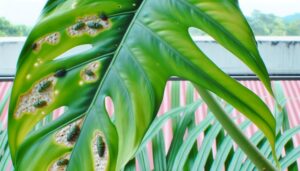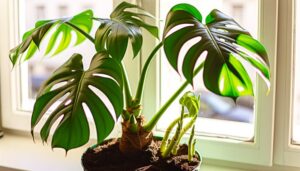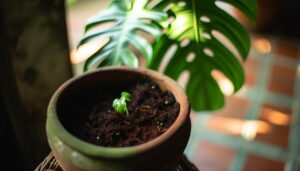Monstera Siltepecana El Salvador Mature
To cultivate a Monstera Siltepecana from El Salvador to maturity, maintain temperatures between 18-27°C and high humidity above 60%. Mature leaves can grow up to 30 cm long with striking silver-green hue and darker veining.
Provide 6-8 hours of bright, indirect light daily at 10,000 to 20,000 lux. Water every 7-10 days, keeping soil moisture at 40-60%.
Use a well-draining substrate with a pH of 5.5-6.5, and fertilize with a balanced 20-20-20 NPK solution every 4-6 weeks. Prune regularly and use proper tools to encourage healthy growth, and there's so much more to uncover about this fascinating plant.

Key Takeaways
- Mature Monstera Siltepecana leaves develop splits and can reach up to 30 cm in length.
- Thrives in high humidity (60%+) and consistent temperatures between 18-27°C.
- Requires 6-8 hours of bright, indirect light daily for optimal growth.
- Propagate using stem cuttings with nodes and aerial roots, rooting within 4-6 weeks.
- Apply balanced 20-20-20 NPK fertilizer every 4-6 weeks, diluted to half strength.
Origin and History

Monstera siltepecana, native to the tropical rainforests of El Salvador, has a rich history rooted in its unique adaptive growth patterns and ecological niche.
You'll find this species thriving in lowland forests at altitudes ranging from 600 to 1,200 meters. Its climbing nature allows it to scale tree trunks, utilizing aerial roots to anchor itself securely.
This hemiepiphytic plant starts as a terrestrial seedling, then shifts to an epiphytic lifestyle as it matures. It's adapted to the high humidity and consistent rainfall of its native habitat, where temperatures typically range between 20°C to 30°C.
Unique Features
Understanding its natural habitat provides insight into the unique features of Monstera siltepecana, such as its remarkable fenestration pattern and distinct silver-green foliage. Native to the tropical rainforests of Central America, this species exhibits adaptations designed for survival in humid, shaded environments.
Monstera siltepecana is known for its striking juvenile leaves that transform as the plant matures, developing perforations and deep splits.
Key features include:
- Fenestrations: Juvenile leaves are intact, while mature leaves develop characteristic splits.
- Foliage Color: The leaves exhibit a unique silver-green hue with darker green veining.
- Leaf Size: Mature leaves can reach up to 30 cm in length.
- Climbing Habit: Uses aerial roots to anchor and climb on surfaces, mimicking its natural epiphytic growth.
Ideal Growing Conditions

To secure Monstera siltepecana thrives, sustain an environment with consistent temperatures between 18-27°C (64-81°F) and humidity levels above 60%.
You should place it in a well-draining substrate, rich in organic matter. A mix of peat moss, perlite, and orchid bark secures optimal aeration and moisture retention.
Water the plant when the top 2-3 cm (1 inch) of soil feels dry, avoiding waterlogging which can lead to root rot.
Incorporate a balanced, water-soluble fertilizer, such as 20-20-20, diluted to half-strength, every 4-6 weeks during the growing season.
Ensure good air circulation around the plant to prevent fungal issues. Regularly check for pests like spider mites and scale insects, treating promptly to maintain plant health.
Light Requirements
In addition to ideal growing conditions, Monstera siltepecana requires bright, indirect light for at least 6-8 hours daily to promote healthy growth and vibrant foliage. Direct sunlight can scorch the leaves, while insufficient light can lead to leggy growth and dull coloration.
To enhance light conditions, consider the following:
- Light Intensity: 10,000 to 20,000 lux
- Light Duration: 6-8 hours of indirect sunlight
- Window Placement: East or west-facing windows are the most suitable
- Artificial Lighting: Full-spectrum LED grow lights
Ensuring your Monstera siltepecana receives the proper light will help maintain its striking leaf patterns and robust growth. Avoid placing it in low-light areas, which can hinder its development and overall health.
Watering Needs
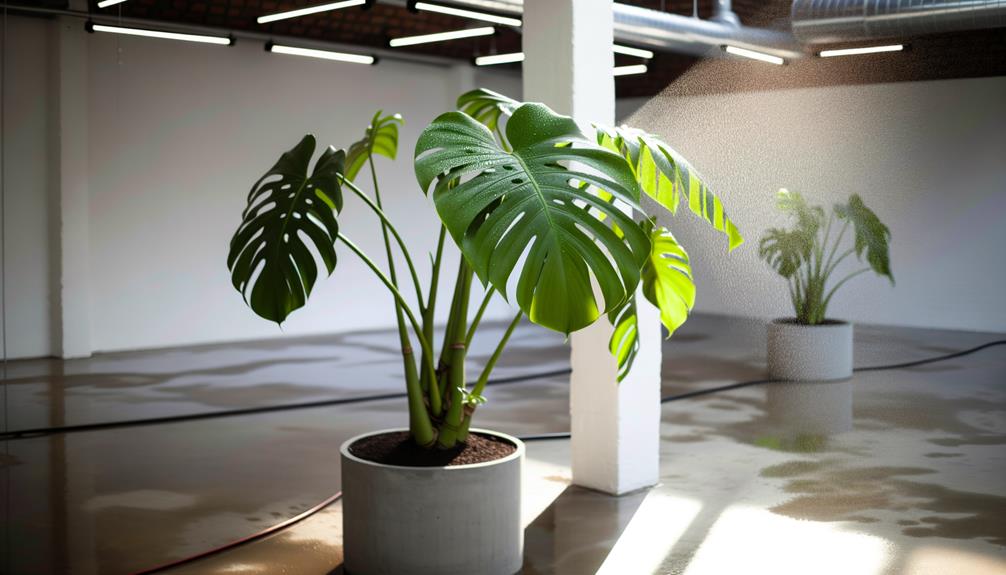
To optimize the growth of Monstera siltepecana El Salvador, maintain soil moisture at 40-60% relative humidity.
Watering frequency should be adjusted to every 7-10 days, ensuring the top 2-3 cm of soil dry out between waterings.
Seasonal changes necessitate reduced watering during winter dormancy to prevent root rot.
Ideal Moisture Levels
Monstera siltepecana El Salvador requires consistently moist soil, maintaining a moisture level of approximately 60-70% for best growth. Maintaining optimal soil moisture is essential for the plant's health, as it prevents root desiccation and promotes vigorous growth. You should monitor the soil's moisture content using a hygrometer or moisture meter for precision.
Key considerations for maintaining ideal moisture levels:
- Soil Composition: Use well-aerated, organic-rich soil to retain moisture without causing waterlogging.
- Drainage: Ensure the pot has sufficient drainage holes to prevent root rot.
- Humidity: Maintain ambient humidity between 60-80% to complement soil moisture.
- Mulching: Apply a thin layer of organic mulch to help retain soil moisture.
Understanding these factors will help you provide the best growing conditions for your Monstera siltepecana El Salvador.
Watering Frequency Guide
How often should you water your Monstera siltepecana El Salvador to guarantee it thrives? Water this species when the top 2 inches (5 cm) of soil feel dry to touch.
Use a well-draining substrate, such as a mix of peat, perlite, and orchid bark, to prevent waterlogging. During each watering session, aim for thorough saturation until water drains out of the pot's bottom. Avoid leaving the plant in standing water to reduce root rot risk.
Monitor soil moisture levels with a moisture meter (range: 4-7). This precision ensures peak hydration without overwatering. Adjust watering frequency based on indoor humidity levels, generally every 7-10 days.
Consistency in this regimen promotes robust growth and vibrant foliage.
Seasonal Watering Changes
Seasonal variations greatly impact the watering needs of Monstera siltepecana El Salvador, with higher frequencies required during the growing season and reduced watering in dormancy. During spring and summer, when the plant exhibits active growth, you should water it every 5-7 days, ensuring the soil stays consistently moist but not waterlogged.
Conversely, in the fall and winter months, when the plant enters dormancy, reduce watering to every 10-14 days.
Key factors to take into account:
- Soil Moisture: Maintain soil at 60-70% moisture during growing season.
- Temperature: Higher temperatures increase evaporation, necessitating more frequent watering.
- Humidity: Higher humidity levels can reduce the need for frequent watering.
- Light Exposure: More light accelerates water uptake, requiring adjustments in watering schedule.
Soil Preferences
For best growth, you'll want to use a well-draining soil mix composed of equal parts peat moss, perlite, and orchid bark.
Guarantee the soil retains adequate moisture without becoming waterlogged, which can lead to root rot.
Aim for a slightly acidic to neutral pH level, ideally between 5.5 and 7.
Ideal Soil Composition
Monstera siltepecana thrives in a well-draining soil mixture composed of 40% peat moss, 30% perlite, and 30% pine bark, maintaining ideal aeration and moisture retention.
Peat moss (Sphagnum spp.) enhances the substrate's water-holding capacity, while perlite (expanded volcanic glass) provides necessary drainage and prevents compaction. Pine bark (Pinus spp.) adds organic matter, further supporting root health and aeration.
This precise blend mimics the plant's natural epiphytic environment, promoting robust growth.
Key benefits of this soil composition include:
- Optimal pH balance: Maintains a slightly acidic to neutral pH.
- Enhanced aeration: Prevents root rot and supports oxygen availability.
- Effective drainage: Reduces the risk of overwatering.
- Sustained nutrient release: Supports long-term plant health.
Understanding these components supports your Monstera siltepecana to flourish.
Moisture Retention Needs
Ensuring consistent moisture levels in the soil is crucial for the health of Monstera siltepecana, as it prefers a substrate that retains sufficient moisture without becoming waterlogged.
You should use a well-draining mix composed of 40% perlite, 30% pine bark, and 30% peat moss to achieve ideal moisture retention. This combination offers aeration while holding ample water.
Regularly monitor the substrate's moisture content using a soil moisture meter, aiming for a reading of 4-6 on a scale of 1-10. Water the plant when the top 2-3 centimeters of the soil feel dry to the touch.
Avoid letting the soil dry out completely, as the Monstera siltepecana thrives in consistently moist conditions.
Ph Level Preferences
To enhance growth for Monstera siltepecana, maintain the soil pH within the slightly acidic range of 5.5 to 6.5. This specific pH range ensures ideal nutrient availability and root health. Regularly test your soil using a pH meter or soil analysis kit.
Adjust the pH by amending with elemental sulfur to lower it or agricultural lime to increase it.
- Elemental Sulfur: Lowers soil pH effectively.
- Agricultural Lime: Increases soil pH gradually.
- pH Meter: Provides accurate and immediate pH readings.
- Soil Analysis Kit: Offers thorough pH and nutrient analysis.
Fertilizing Tips
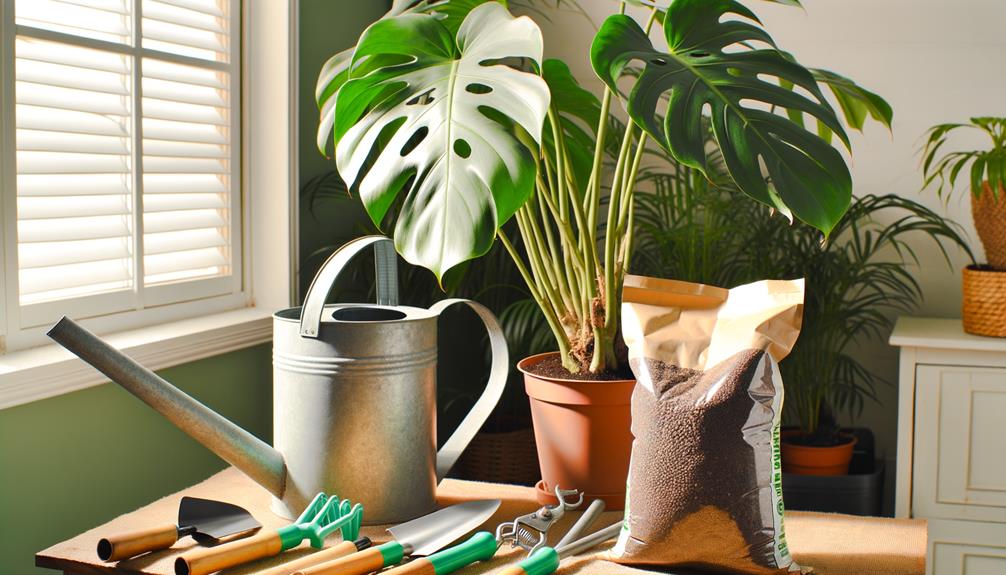
Regularly applying a balanced 20-20-20 NPK fertilizer every four to six weeks will support the vigorous growth of your Monstera siltepecana El Salvador. Guarantee the fertilizer contains essential micronutrients like magnesium (Mg), iron (Fe), and manganese (Mn).
Dilute the fertilizer to half strength to avoid nutrient burn, using 5 milliliters per liter of water. Apply the solution during the plant's active growing phase, typically spring and summer.
Monitor for signs of over-fertilization, such as yellowing leaves or salt buildup on the soil surface. If these occur, flush the soil with distilled water to remove excess salts.
Avoid fertilizing during the plant's dormant period in winter, as this can lead to root damage and hinder growth.
Pruning Techniques
To maintain your Monstera siltepecana El Salvador, schedule pruning sessions every 6-8 weeks using sterilized, sharp pruning shears.
Cut back stems just above a node to encourage new growth and maintain plant health.
Proper tool usage and timing are essential to prevent disease and promote vigorous development.
Timing and Frequency
Regularly pruning Monstera siltepecana during its active growing season, typically from late spring to early summer, is important to optimize plant health and growth. It's recommended to prune once every 3-4 weeks during this period.
Focus on removing dead or damaged leaves and stems, as well as any that show signs of disease. This assists the plant in allocating resources more efficiently and promotes robust growth.
- Timing: Late spring to early summer
- Frequency: Every 3-4 weeks
- Targets: Dead, damaged, or diseased leaves and stems
- Objective: Resource allocation and growth promotion
Consistent pruning helps Monstera siltepecana maintain its vibrant appearance and health, encouraging the development of lush, mature foliage.
Proper Tools Usage
After determining the best timing and frequency for pruning, it's essential to select the right tools to guarantee clean cuts and prevent plant damage.
Use sterilized, sharp bypass pruners for stems, making sure a blade gap of 0.5mm for precision. Opt for pruning shears with carbon steel blades to minimize pathogen transfer.
When trimming aerial roots, a pair of fine-tip snips, like those with a 2.5cm cutting edge, will offer control and precision. Remember to disinfect tools with a 70% isopropyl alcohol solution before and after use.
Avoid anvil pruners, as they can crush the Monstera Siltepecana's (Monstera siltepecana) delicate tissues. Proper tool selection will guarantee your plant stays healthy and thrives.
Encouraging New Growth
Strategically removing no more than 25% of the Monstera siltepecana's foliage at any one time promotes vigorous new growth and maintains the plant's overall health.
When pruning, use sterilized, sharp pruning shears to make clean cuts just above a node, where a leaf joins the stem. This encourages the development of new axillary buds.
Focus on cutting away:
- Dead or damaged leaves: Prevents disease spread.
- Overgrown stems: Enhances air circulation.
- Crossing branches: Reduces structural stress.
- Weak growth: Directs energy to stronger parts.
Propagation Methods
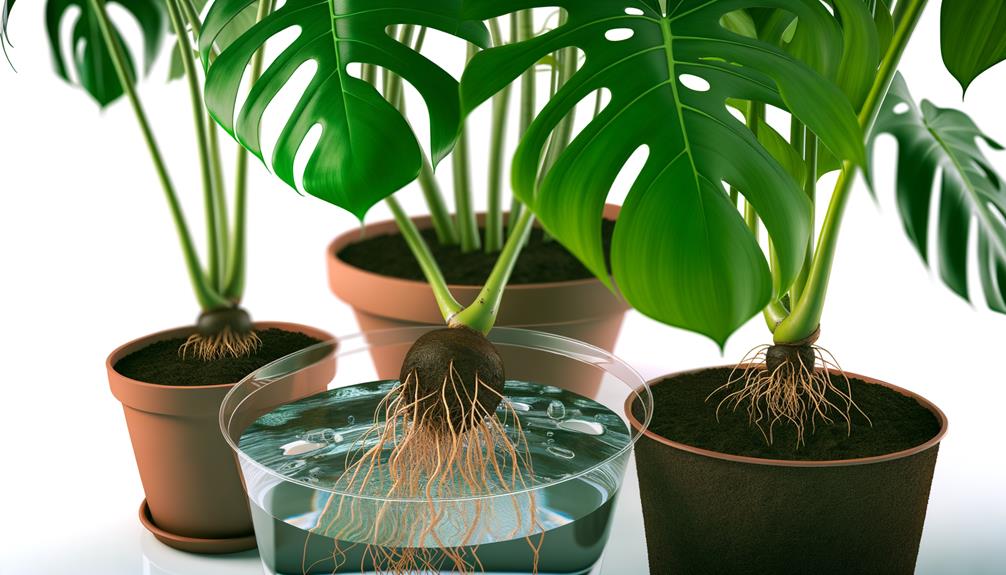
To propagate Monstera siltepecana 'El Salvador' mature plants, you can use stem cuttings with at least one node and aerial root, guaranteeing ideal growth and development.
First, sterilize your pruning shears with isopropyl alcohol to prevent pathogen transfer. Cut a 10-15 cm (4-6 inches) stem section, ensuring it has a prominent aerial root.
Place the cutting in a water container or directly into a well-draining potting mix composed of equal parts peat moss and perlite. Maintain humidity around 60-70% and keep temperatures between 20-25°C (68-77°F).
Provide indirect, bright light exposure to avoid leaf scorch. Change water weekly if using the water method. Roots should develop in 4-6 weeks, at which point you can transplant into a larger pot.
Common Pests
Though generally resilient, Monstera siltepecana 'El Salvador' mature plants can fall victim to common pests like spider mites (Tetranychus urticae) and mealybugs (Pseudococcidae). Spider mites thrive in dry conditions and cause stippling on leaves by sucking plant sap. Mealybugs are often found in leaf axils and produce honeydew, leading to sooty mold.
To maintain your plant's health, regularly inspect for:
- Spider mites: Look for fine webbing on the underside of leaves.
- Mealybugs: Check for cotton-like masses in leaf junctions.
- Thrips (Thysanoptera): Notice silver streaks on leaves.
- Aphids (Aphididae): Spot clusters on new growth and buds.
Prompt treatment with insecticidal soap or neem oil can mitigate infestations and protect your Monstera siltepecana.
Disease Prevention

How can you effectively prevent diseases in your Monstera siltepecana 'El Salvador' mature plant? First, maintain adequate air circulation for your plant. Use a fan or rotate the plant to minimize fungal infections. Second, water the plant at the soil level, avoiding foliar wetting to deter bacterial leaf spot. Third, sustain a consistent temperature range of 18-24°C (64-75°F) to decrease stress, which can render the plant vulnerable to pathogens.
| Practice | Benefit | Scientific Basis |
|---|---|---|
| Sufficient air circulation | Reduces fungal infections | Prevents spore germination |
| Soil-level watering | Prevents bacterial leaf spot | Limits water contact with foliage |
| Consistent temperature | Reduces plant stress | Keeps plant metabolism stable |
Implementing these measures will help keep your Monstera siltepecana healthy.
Styling and Display
Incorporate Monstera siltepecana 'El Salvador' into your home's decor by strategically positioning it in well-lit areas with indirect sunlight to accentuate its unique silver-veined foliage. Aim for light levels of 10,000 to 20,000 lux. Confirm the relative humidity is maintained at 60-80% to mimic its native tropical environment.
- Mount on a moss pole: Promotes vertical growth and supports aerial roots.
- Use a hanging basket: Creates a cascading effect, showcasing its trailing habit.
- Group with other aroids: Enhances the tropical aesthetic and stabilizes humidity.
- Place near a north-facing window: Provides the ideal light intensity without direct sunburn.
Monitor soil moisture levels, keeping it slightly moist but not waterlogged, to prevent root rot (Phytophthora spp.).
Conclusion
To sum up, cultivating a Monstera siltepecana in El Salvador provides a gratifying experience because of its flexibility and impressive foliage.
For example, envision a gardener who multiplies this species via stem cuttings and witnesses a 95% success rate.
By upholding ideal conditions—60-80% humidity, bright indirect light, and regular watering—you can promote strong growth.
Grasping its distinct requirements, such as managing pests like spider mites and aphids, will assist you in nurturing a flourishing Monstera siltepecana.

